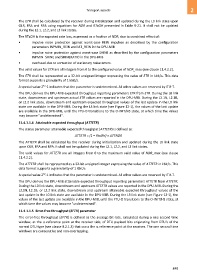Page 859 - 5G Basics - Core Network Aspects
P. 859
Transport aspects 2
The ETR shall be calculated by the receiver during initialization and updated during the L0 link state upon
OLR, FRA and RPA using equations for NDR and RTxOH presented in Table 9-21. It shall not be updated
during the L2.1, L2.2, and L3 link states.
The RTxOH is the expected rate loss, expressed as a fraction of NDR, due to combined effect of:
• impulse noise protection against worst-case REIN impulses as described by the configuration
parameters INPMIN_REIN and IAT_REIN in the DPU-MIB
• impulse noise protection against worst-case SHINE as described by the configuration parameters
INPMIN_SHINE and SHINERATIO in the DPU-MIB
• overhead due to correction of stationary noise errors.
The valid values for ETR are all integers from 0 to the configured value of NDR_max (see clause 11.4.2.2).
The ETR shall be represented as a 32-bit unsigned integer expressing the value of ETR in kbit/s. This data
format supports a granularity of 1 kbit/s.
32
A special value 2 -1 indicates that the parameter is undetermined. All other values are reserved by ITU-T.
The DPU derives the DPU-MIB expected throughput reporting parameters ETR from ETR. During the L0 link
state, downstream and upstream actual ETR values are reported in the DPU-MIB. During the L2.1N, L2.1B,
or L2.2 link state, downstream and upstream expected throughput values of the last update in the L0 link
state are available in the DPU-MIB. During the L3 link state (see Figure 12-1), the values of the last update
are available in the DPU-MIB, until the FTU-O transitions to the O-INIT/HS state, at which time the values
may become "undetermined".
11.4.1.1.4 Attainable expected throughput (ATTETR)
The status parameter attainable expected throughput (ATTETR) is defined as:
ATTETR = (1 – RtxOH) × ATTNDR
The ATTETR shall be calculated by the receiver during initialization and updated during the L0 link state
upon OLR, FRA and RPA. It shall not be updated during the L2.1, L2.2, and L3 link states.
The valid values for ATTETR are all integers from 0 to the maximum valid value of NDR_max (see clause
11.4.2.2).
The ATTETR shall be represented as a 32-bit unsigned integer expressing the value of ATTETR in kbit/s. This
data format supports a granularity of 1 kbit/s.
32
A special value 2 -1 indicates that the parameter is undetermined. All other values are reserved by ITU-T.
The DPU derives the DPU-MIB attainable expected throughput reporting parameters ATTETR from ATTETR.
During the L0 link state, downstream and upstream ATTETR values are reported in the DPU-MIB. During the
L2.1N, L2.1B, or L2.2 link state, downstream and upstream attainable expected throughput values of the
last update in the L0 link state are available in the DPU-MIB. During the L3 link state (see Figure 12-1), the
values of the last update are available in the DPU-MIB, until the FTU-O transitions to the O-INIT/HS state, at
which time the values may become "undetermined".
11.4.1.1.5 Error-free throughput (EFTR) parameter
The error-free throughput (EFTR) is defined as the average bit-rate, calculated during a one second time
window, at the reference point at the receiver side, of DTU payload bits originating from DTU's of the
normal DTU type (see clause 8.2.1.3) that cross the reference point at the receiver. The one second time
windows are consecutive and non-overlapping.
849

